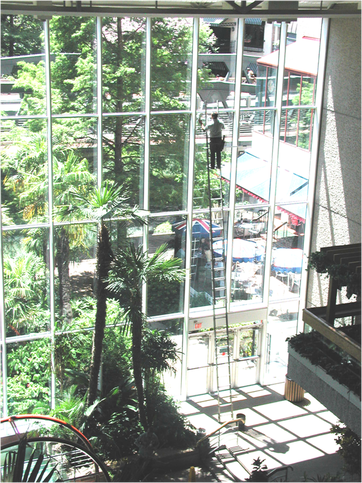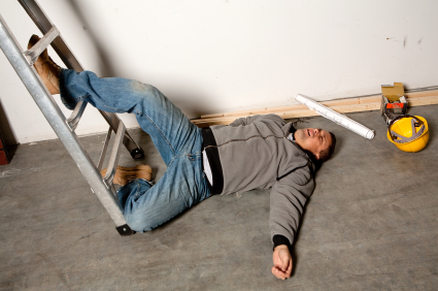Stairway to Heaven (part 2)
A Story to Help Us Think About How We Think About Workplace Safety

by Jim Kleinsteuber
(for Part 1 of this series, go here.)
In Part 1 of this series, I left you to ponder some questions about how safe our window washer friend "Bob’s" actions were. As you'll remember, he is without fall protection and performing the task without signs, barricades or warnings and the public is wandering below in and out of the double doors to and from the Riverwalk to the hotel lobby.
One of the most frequent comments I hear when I tell this story is, "He must be crazy!"
In your own organization, would anything like this be permitted? What would you do if you saw a worker who was one error away from a serious injury or even death to himself or another?
I'm sure Bob can recall at least one or two “close calls” in his career as a window washer working at heights. The first principle of Human Performance is: “People are fallible and even the best make mistakes.” It's not a question of whether Bob will make a mistake; it's a question of when. (I'll have more to say about Human Performance Fundamentals in a future article.)
As I mentioned in Part 1, I took the pictures during a break at a conference in San Antonio. As I was taking these shots a hotel management representative was walking by, and I spoke to him about the potential threat to Bob's safety and to the public.
He immediately asked me, “Are you from OSHA?”
I replied, "No, I'm not, but I'm very concerned about the worker's safety."
He said, “He is a contractor.” End of conversation, and the hotel manager proceeded to leave. Within minutes, Bob finished the window bay he was working on and started to shift to the next bay. Before he could finish setting up, Bob turned, listened to someone to his right (out of my line of sight), and he appeared to be getting aggravated. He then looked back to the second floor, where I was standing, and walked off and out of sight.
After about ten minutes, the break ended, and we all returned to our respective conference rooms.
What do you suppose happened next? When none of us "safety types" was looking, Bob went right back up the ladder and finished his job!
(for Part 1 of this series, go here.)
In Part 1 of this series, I left you to ponder some questions about how safe our window washer friend "Bob’s" actions were. As you'll remember, he is without fall protection and performing the task without signs, barricades or warnings and the public is wandering below in and out of the double doors to and from the Riverwalk to the hotel lobby.
One of the most frequent comments I hear when I tell this story is, "He must be crazy!"
In your own organization, would anything like this be permitted? What would you do if you saw a worker who was one error away from a serious injury or even death to himself or another?
I'm sure Bob can recall at least one or two “close calls” in his career as a window washer working at heights. The first principle of Human Performance is: “People are fallible and even the best make mistakes.” It's not a question of whether Bob will make a mistake; it's a question of when. (I'll have more to say about Human Performance Fundamentals in a future article.)
As I mentioned in Part 1, I took the pictures during a break at a conference in San Antonio. As I was taking these shots a hotel management representative was walking by, and I spoke to him about the potential threat to Bob's safety and to the public.
He immediately asked me, “Are you from OSHA?”
I replied, "No, I'm not, but I'm very concerned about the worker's safety."
He said, “He is a contractor.” End of conversation, and the hotel manager proceeded to leave. Within minutes, Bob finished the window bay he was working on and started to shift to the next bay. Before he could finish setting up, Bob turned, listened to someone to his right (out of my line of sight), and he appeared to be getting aggravated. He then looked back to the second floor, where I was standing, and walked off and out of sight.
After about ten minutes, the break ended, and we all returned to our respective conference rooms.
What do you suppose happened next? When none of us "safety types" was looking, Bob went right back up the ladder and finished his job!

Now, I never met Bob, but I'm sure he is neither crazy nor an idiot. He's just a professional trying to get the job done. Bob has probably never fallen from a ladder at that height and he did not fall that day, thankfully.
Why would Bob (or anyone else) risk his/her life for a pay check? This brings us to another principle of Human Performance, “Individual behavior is influenced by organizational processes and values.” There are systems in place supporting the activity. As long as OSHA was not involved, the worker was a contractor; the management system supported, even encouraged, and approved the behavior and gambled on a successful outcome of a task.
Every safety professional worth his salt can come up with a safer way to do this task that provides the worker, the public and the hotel the same outcome with layers of safety defenses and protection built into the task. A powered man lift, for example: it might mean an initial financial expenditure but compared to the loss potential it is cheap in comparison. This one-time expense would increase production and prevent a very expensive (not to mention tragic) accident.
A safe worker is always a more productive worker.
Why would Bob (or anyone else) risk his/her life for a pay check? This brings us to another principle of Human Performance, “Individual behavior is influenced by organizational processes and values.” There are systems in place supporting the activity. As long as OSHA was not involved, the worker was a contractor; the management system supported, even encouraged, and approved the behavior and gambled on a successful outcome of a task.
Every safety professional worth his salt can come up with a safer way to do this task that provides the worker, the public and the hotel the same outcome with layers of safety defenses and protection built into the task. A powered man lift, for example: it might mean an initial financial expenditure but compared to the loss potential it is cheap in comparison. This one-time expense would increase production and prevent a very expensive (not to mention tragic) accident.
A safe worker is always a more productive worker.
The 5 Human Performance Improvement Principles (HPI):
Institute of Nuclear Power Operators (INPO)
- People are fallible, and even the best make mistakes
- Error-likely situations are predictable, manageable, and preventable.
- Individual behavior is influenced by organizational processes and values.
- People achieve high levels of performance based largely on the encouragement and reinforcement received from leaders, peers, and subordinates.
- Events can be avoided by understanding the reasons mistakes occur and applying lessons learned from past events.
